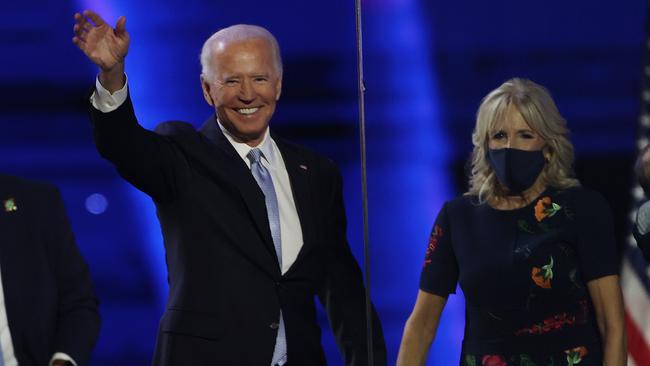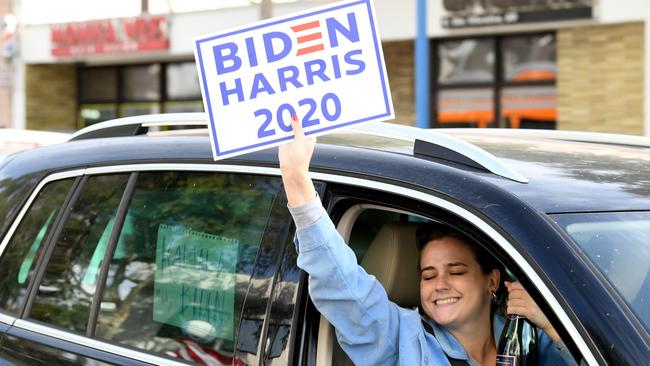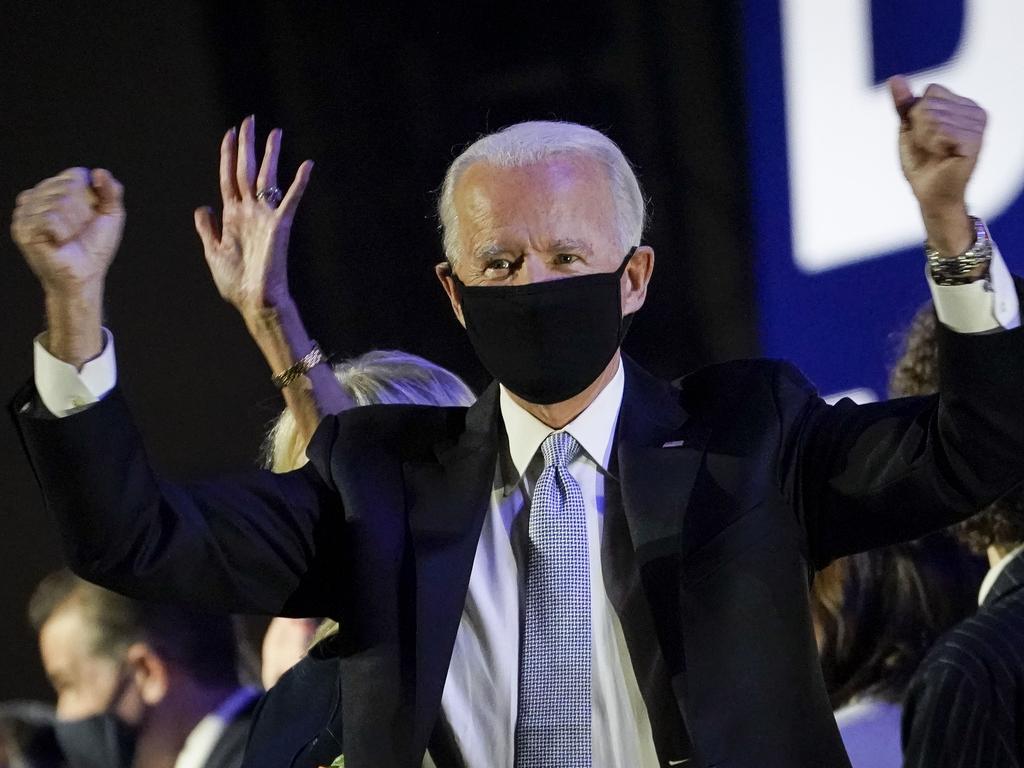For business, Biden bodes a less hospitable but more predictable presidency
Agenda of higher taxes and regulations could be restrained by Senate and conservative judges.

The election looks like it may yield a dream scenario for business: a moderate Democratic president whose more aggressive plans can’t pass the Senate, but who eschews the unpredictability that has often marked the Trump administration.
Joe Biden, who appears to have garnered the 270 electoral college votes needed to win the election, ran on one of the most progressive Democratic platforms in decades. It envisions increased taxes on investors and businesses, a public health insurance option for Obamacare, lower prices on drugs and bold plans to confront climate change and empower unions.
The legislation needed to implement much of that agenda might not get past the Senate. Based on the likely outcome of races yet to be called including expected runoffs in Georgia, Republicans have the edge to keep control. More fiscal stimulus is still likely, though less than congressional Democrats had proposed.
Mr. Biden can still wield considerable influence through executive actions and regulatory agencies, but those may be curbed by a more conservative judiciary and a Senate disinclined to confirm left-of-center appointees.
A Biden presidency would also break with some features of Mr. Trump’s administration that weren’t popular with business: tense trade relations with other countries marked by the frequent use or threat of tariffs, restrictions on foreign workers and sharp criticism of companies, by name, on Twitter.
Business executives’ biggest current preoccupation is the resurgent pandemic. Since a vaccine may not be widely available before spring, they worry about new lockdowns to tamp down infections.
Mr. Biden said late in the campaign, “I’m not going to shut down the economy. I’m going to shut down the virus.” To do that, he has promised the federal government will be more proactive than under Mr. Trump, who mostly let states take the lead.
Mr. Biden would mandate masks on federal property while urging state and local governments to require them as well. He would produce federal guidelines on when and how much states, schools and localities should dial social-distancing restrictions up or down depending on local infections. He would direct more federal resources toward the development of faster, more convenient tests to detect Covid-19 and more drive-through sites for testing and contact tracing.
These steps could potentially bring the pandemic under control faster at the expense of near-term economic disruptions from localized, targeted lockdowns. But Mr. Biden, like Mr. Trump, can’t compel states to comply, and many Republican governors would probably resist.
Businesses are also counting on more federal stimulus to speed up the recovery, a prospect that has buoyed stocks. Mr. Biden hasn’t specified the details of any stimulus he would propose as president, since that would depend on what is enacted before the current Congress adjourns. Democrats had originally sought at least $2 trillion, including support for state and local governments to avoid layoffs; enhanced unemployment insurance benefits; and a refilled “paycheck protection program” for small business.

But with Republicans hopeful of retaining control of the Senate, they will continue to oppose that much aid, and a final package likely will be far smaller.
Mr. Biden’s tax plans include raising the corporate tax rate to 28% from its current 21% (though still below 35%, where it stood under President Obama) and the minimum tax on foreign income to 21% from 10.5%. He has also pledged to repeal the 20% deduction for wealthy individuals’ “pass-through” business income. If they control the Senate, Republicans would likely block any of these proposals.
Mr. Biden’s plans for a public-insurance option in Obamacare and reduced drug prices would have squeezed health companies. But those plans stand little chance in a Republican-controlled Senate, at least in their current form.
Because Mr. Biden could implement much of his labor and environment agenda through executive action and regulatory agencies, much rides on whom he appoints, a signal whether his approach will be more conciliatory or confrontational.
During the election he often reassured business leaders their world wouldn’t fundamentally change. Companies would be more likely to believe that if, for example, he picked Federal Reserve governor Lael Brainard, an economist who served under Barack Obama, to serve as treasury secretary. Conversely, they’d be alarmed if he chose Sen. Elizabeth Warren of Massachusetts or someone similarly on the party’s left. Ms. Brainard’s confirmation would probably also face fewer obstacles in the Senate.
Oil-and-gas companies and fossil fuel-reliant utilities are at risk from Mr. Biden’s climate agenda, while renewable-energy providers would benefit. His proposal to drive net carbon emissions to zero in electricity by 2035 and across the economy by 2050 relies more on carrots than sticks: more federal research and development and investment in infrastructure, such as electricity transmission. Yet these require funding from Congress and thus would have to win over some Republican senators.
His regulators will likely raise vehicle fuel-efficiency requirements and toughen restrictions on methane leaks from oil and gas facilities — Obama-era steps that Mr. Trump partly rolled back. Similarly, businesses of all sizes will face labor-friendly regulators on overtime pay, bargaining rights for franchise employees and gig-worker rights.
But Mr. Trump is leaving behind obstacles to Mr. Biden’s regulatory agenda. The current president’s appointees will, for a while, still run key agencies, including the Fed and Securities and Exchange Commission. Republicans are slated to hold a majority on the National Labor Relations Board until August 2021 and the Equal Employment Opportunity Commission until July 2022. His Environmental Protection Agency has been trying to narrow the criteria for regulating greenhouse-gas emissions to make it harder for successors to toughen them.
Potentially more consequential, 50% of federal judges, who have lifetime tenure, are now Republican-appointed, up from 42% when Mr. Trump took office, including six of the Supreme Court’s nine justices.
Recent Republican court appointees are particularly wary of what they consider executive overreach. They had already blocked many of Mr. Obama’s rules, including the Clean Power Plan to limit greenhouse gas emissions from electricity generation, and expanded overtime, from going into effect. (Mr. Trump implemented his own, narrower overtime rule.) Unable to stop Mr. Biden through the political process, Republican governors and business groups may succeed in court.
Businesses will welcome some parts of Mr. Biden’s agenda, in particular his commitment to better trade relations with U.S. allies. Whether he will remove Mr. Trump’s tariffs on China is unclear, but Mr. Biden is unlikely to impose new ones. He will likely ease access to high-skilled foreign workers that Mr. Trump had steadily restricted. Mr. Biden is also less likely to attack companies by name or announce abrupt policy shifts over Twitter.
In all, a Biden presidency will be slightly less hospitable to business than Mr. Trump’s but also more predictable and, many business leaders hope, boring.
The Wall Street Journal







To join the conversation, please log in. Don't have an account? Register
Join the conversation, you are commenting as Logout